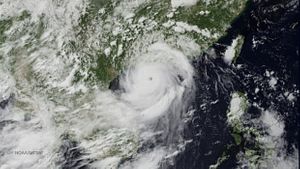Typhoon season is underway in the Asia-Pacific, as the strongest storm so far this year tore its way through the Philippines and China. Typhoon Rammasun (also known as Glenda) hit south of Manila on the Philippine island of Luzon before moving west toward China’s Hainan Island. As of midday on Friday, sustained wind speeds were estimated at over 230 kilometers per hour, making Rammasun a Category 4 storm (and just short of being officially classified a “super typhoon”).
In the Philippines, Typhoon Rammasun is reported to have killed over 60 people, with an additional 100 injured. Over 500,000 had sought refuge in evacuation centers. The typhoon knocked out power for millions and destroyed roads and bridges. The Wall Street Journal estimated the total infrastructure damage at $21 million. An additional $15 million in damages was done to crops, Reuters reported.
The silver lining, according to National Disaster Agency head Alexander Pama, is that the government was better prepared to deal with Typhoon Rammasun after having experienced the devastation caused by last November’s Typhoon Haiyan. Pama told Reuters that the government started evacuating people from high-risk areas well before Rammasun touched down. Luckily, the areas hardest hit by Haiyan, which are still rebuilding, largely avoided Rammsun’s impact.
Rammasun also hit Hainan Island hard, becoming the strongest typhoon to touch down in southern China in over 40 years, according to Xinhua. More than 70,000 people were evacuated from Hainan, a popular tourist destination, in advance of the storm. Xinhua reported at least one dead due to the typhoon, which also knocked out power and water supplies in the provincial capital of Haikou. After hitting Hainan, the typhoon moved west to mainland China, where it made landfall in Guangdong province.
The effects of the typhoon are expected to plague southern China throughout the weekend. Large areas of the region have already suffered devastating floods in the past week — as of Thursday, floods caused by heavy rain had killed at least 34, with another 21 missing. Guizhou province alone saw the evacuation of nearly 170,000 due to floods and landslides. Now this area will received more heavy rain due to Typhoon Rammasun.
Rammasun is also expected to touch down in northern Vietnam on Saturday morning. In preparation, the government has evacuated over 118,000 people from its northern provinces, the Wall Street Journal reported.

































